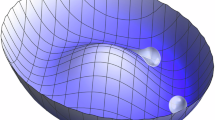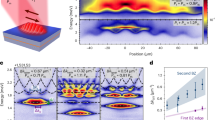Abstract
Second-order phase transitions are governed by a spontaneous symmetry-breaking mechanism, which yields collective excitations with a gapless spectrum called Nambu–Goldstone modes. Although these modes propagate as sound waves in conservative systems, non-equilibrium phase transitions have been predicted to feature a diffusive Nambu–Goldstone mode. Here, we present the experimental characterization of such a mode in a non-equilibrium Bose–Einstein condensate of microcavity polaritons. The mode appears in the spectroscopic response of the condensate to an extra probe laser as spectral narrowing, along with the emergence of a tilted frequency plateau. Breaking the symmetry with another phase-fixing beam causes a gap to open in the imaginary part of the spectrum and the disappearance of the Nambu–Goldstone mode. These observations confirm theoretical predictions for the Nambu–Goldstone mode of non-equilibrium phase transitions and reveal the symmetry-breaking mechanism underlying polariton condensation.
This is a preview of subscription content, access via your institution
Access options
Access Nature and 54 other Nature Portfolio journals
Get Nature+, our best-value online-access subscription
$32.99 / 30 days
cancel any time
Subscribe to this journal
Receive 12 print issues and online access
$259.00 per year
only $21.58 per issue
Buy this article
- Purchase on SpringerLink
- Instant access to full article PDF
Prices may be subject to local taxes which are calculated during checkout



Similar content being viewed by others
Data availability
The raw data are available via Zenodo at https://doi.org/10.5281/zenodo.15079205 (ref. 57).
References
Huang, K. Introduction to Statistical Physics 2nd edn (CRC, 2010).
Sachdev, S. Quantum Phase Transitions 2nd edn (Cambridge Univ. Press, 2011).
Nambu, Y. & Jona-Lasinio, G. Dynamical model of elementary particles based on an analogy with superconductivity. I. Phys. Rev. 122, 345–358 (1961).
Goldstone, J. Field theories with ‘superconductor’ solutions. Il Nuovo Cimento (1955-1965) 19, 154–164 (1961).
Goldstone, J., Salam, A. & Weinberg, S. Broken symmetries. Phys. Rev. 127, 965–970 (1962).
Lange, R. V. Nonrelativistic theorem analogous to the Goldstone theorem. Phys. Rev. 146, 301–303 (1966).
Takahashi, D. A. & Nitta, M. Counting rule of Nambu-Goldstone modes for internal and spacetime symmetries: Bogoliubov theory approach. Ann. Phys. 354, 101–156 (2015).
Gunton, J. D. & Buckingham, M. J. Condensation of the ideal Bose gas as a cooperative transition. Phys. Rev. 166, 152–158 (1968).
Pitaevskii, L. & Stringari, S. Bose-Einstein Condensation and Superfluidity (Oxford Univ. Press, 2016).
Steinhauer, J., Ozeri, R., Katz, N. & Davidson, N. Excitation spectrum of a Bose-Einstein condensate. Phys. Rev. Lett. 88, 120407 (2002).
Schmittmann, B. & Zia, R. Statistical Mechanics of Driven Diffusive Systems (Elsevier, 1995).
Hidaka, Y. & Minami, Y. Spontaneous symmetry breaking and Nambu-Goldstone modes in open classical and quantum systems. Prog. Theor. Exp. Phys. 2020, 033A01 (2020).
Bloch, J., Carusotto, I. & Wouters, M. Non-equilibrium Bose-Einstein condensation in photonic systems. Nat. Rev. Phys. 4, 470–488 (2022).
Graham, R. & Haken, H. The quantum-fluctuations of the optical parametric oscillator. I. Z. Phys. A: Hadrons Nucl. 210, 276–302 (1968).
DeGiorgio, V. & Scully, M. O. Analogy between the laser threshold region and a second-order phase transition. Phys. Rev. A 2, 1170–1177 (1970).
Graham, R. & Haken, H. Laserlight—first example of a second-order phase transition far away from thermal equilibrium. Z. Phys. 237, 31–46 (1970).
Grossmann, S. & Richter, P. H. Laser threshold and nonlinear Landau fluctuation theory of phase transitions. Z. Phys. A: Hadrons Nucl. 242, 458–475 (1971).
Baumberg, J. et al. Parametric oscillation in a vertical microcavity: a polariton condensate or micro-optical parametric oscillation. Phys. Rev. B 62, R16247 (2000).
Stevenson, R. M. et al. Continuous wave observation of massive polariton redistribution by stimulated scattering in semiconductor microcavities. Phys. Rev. Lett. 85, 3680–3683 (2000).
Kasprzak, J. et al. Bose-Einstein condensation of exciton polaritons. Nature 443, 409–414 (2006).
Richard, M. et al. Experimental evidence for nonequilibrium Bose condensation of exciton polaritons. Phys. Rev. B 72, 201301 (2005).
Szymańska, M. H., Keeling, J. & Littlewood, P. B. Nonequilibrium quantum condensation in an incoherently pumped dissipative system. Phys. Rev. Lett. 96, 230602 (2006).
Wouters, M. & Carusotto, I. Goldstone mode of optical parametric oscillators in planar semiconductor microcavities in the strong-coupling regime. Phys. Rev. A 76, 043807 (2007).
Wouters, M. & Carusotto, I. Excitations in a nonequilibrium Bose-Einstein condensate of exciton polaritons. Phys. Rev. Lett. 99, 140402 (2007).
Keeling, J., Szymańska, M. H. & Littlewood, P. B. in Optical Generation and Control of Quantum Coherence in Semiconductor Nanostructures (eds Slavcheva, G. & Roussignol, P.) 293–329 (Springer, 2010).
Dunnett, K. & Szymańska, M. H. Keldysh field theory for nonequilibrium condensation in a parametrically pumped polariton system. Phys. Rev. B 93, 195306 (2016).
Carusotto, I. & Ciuti, C. Quantum fluids of light. Rev. Mod. Phys. 85, 299–366 (2013).
Carusotto, I. & Ciuti, C. Spontaneous microcavity-polariton coherence across the parametric threshold: quantum Monte Carlo studies. Phys. Rev. B 72, 125335 (2005).
Stepanov, P. et al. Dispersion relation of the collective excitations in a resonantly driven polariton fluid. Nat. Commun. 10, 3869 (2019).
Claude, F. et al. High-resolution coherent probe spectroscopy of a polariton quantum fluid. Phys. Rev. Lett. 129, 103601 (2022).
Chow, W. W., Scully, M. O. & Van Stryland, E. W. Line narrowing in a symmetry broken laser. Opt. Commun. 15, 6–9 (1975).
Courtois, J., Smith, A., Fabre, C. & Reynaud, S. Phase diffusion and quantum noise in the optical parametric oscillator: a semiclassical approach. J. Mod. Opt. 38, 177–191 (1991).
Savvidis, P. G. et al. Angle-resonant stimulated polariton amplifier. Phys. Rev. Lett. 84, 1547–1550 (2000).
Baas, A., Karr, J.-P., Romanelli, M., Bramati, A. & Giacobino, E. Quantum degeneracy of microcavity polaritons. Phys. Rev. Lett. 96, 176401 (2006).
Aßmann, M. et al. From polariton condensates to highly photonic quantum degenerate states of bosonic matter. Proc. Natl Acad. Sci. USA 108, 1804–1809 (2011).
Nakayama, M. & Ueda, M. Observation of diffusive and dispersive profiles of the nonequilibrium polariton-condensate dispersion relation in a CuBr microcavity. Phys. Rev. B 95, 125315 (2017).
Ballarini, D. et al. Observation of long-lived polariton states in semiconductor microcavities across the parametric threshold. Phys. Rev. Lett. 102, 056402 (2009).
Pieczarka, M. et al. Observation of quantum depletion in a non-equilibrium exciton-polariton condensate. Nat. Commun. 11, 429 (2020).
Estrecho, E. et al. Low-energy collective oscillations and Bogoliubov sound in an exciton-polariton condensate. Phys. Rev. Lett. 126, 075301 (2021).
Ballarini, D. et al. Directional Goldstone waves in polariton condensates close to equilibrium. Nat. Commun. 11, 217 (2020).
Claude, F. et al. Spectrum of collective excitations of a quantum fluid of polaritons. Phys. Rev. B 107, 174507 (2023).
Wouters, M. & Carusotto, I. Absence of long-range coherence in the parametric emission of photonic wires. Phys. Rev. B 74, 245316 (2006).
Porras, D. & Tejedor, C. Linewidth of a polariton laser: theoretical analysis of self-interaction effects. Phys. Rev. B 67, 161310 (2003).
Love, A. P. D. et al. Intrinsic decoherence mechanisms in the microcavity polariton condensate. Phys. Rev. Lett. 101, 067404 (2008).
Amelio, I. & Carusotto, I. Bogoliubov theory of the laser linewidth and application to polariton condensates. Phys. Rev. A 105, 023527 (2022).
Alaeian, H., Giedke, G., Carusotto, I., Löw, R. & Pfau, T. Limit cycle phase and goldstone mode in driven dissipative systems. Phys. Rev. A 103, 013712 (2021).
Ji, K., Gladilin, V. N. & Wouters, M. Temporal coherence of one-dimensional nonequilibrium quantum fluids. Phys. Rev. B 91, 045301 (2015).
Fontaine, Q. et al. Kardar–Parisi–Zhang universality in a one-dimensional polariton condensate. Nature 608, 687–691 (2022).
Ferrier, A., Zamora, A., Dagvadorj, G. & Szymańska, M. H. Searching for the Kardar-Parisi-Zhang phase in microcavity polaritons. Phys. Rev. B 105, 205301 (2022).
Léonard, J., Morales, A., Zupancic, P., Donner, T. & Esslinger, T. Monitoring and manipulating Higgs and Goldstone modes in a supersolid quantum gas. Science 358, 1415–1418 (2017).
Tanzi, L. et al. Supersolid symmetry breaking from compressional oscillations in a dipolar quantum gas. Nature 574, 382–385 (2019).
Trypogeorgos, D. et al. Emerging supersolidity in photonic-crystal polariton condensates. Nature 639, 337–341 (2025).
Nigro, D. et al. Supersolidity of polariton condensates in photonic crystal waveguides. Phys. Rev. Lett. 134, 056002 (2025).
Ma, R. et al. A dissipatively stabilized Mott insulator of photons. Nature 566, 51–57 (2019).
Clark, L. W., Schine, N., Baum, C., Jia, N. & Simon, J. Observation of Laughlin states made of light. Nature 582, 41–45 (2020).
Ozawa, T. & Price, H. M. Topological quantum matter in synthetic dimensions. Nat. Rev. Phys. 1, 349–357 (2019).
Claude, F. et al. Observation of the diffusive Nambu-Goldstone mode of a non-equilibrium phase transition. Zenodo https://doi.org/10.5281/zenodo.15079205 (2025).
Acknowledgements
We are thankful to J. H. Wilson for enlightening conversations on NG modes in various field theories. We acknowledge financial support from the H2020-FETFLAG-2018-2020 project PhoQuS (n.820392). I.C. acknowledges financial support from the Provincia Autonoma di Trento, from the Q@TN Initiative and from the National Quantum Science and Technology Institute through the PNRR MUR Project (Grant No. PE0000023-NQSTI), co-funded by the European Union - NextGeneration EU. M.J.J. and A.B. acknowledge financial support from the Sirteq DIM. Q.G. and A.B. are members of the Institut Universitaire de France.
Author information
Authors and Affiliations
Contributions
F.C. performed the experiments. F.C. and M.J.J. analysed the data and prepared the figures. Q.G. advised on experimental technical details. M.W. and I.C. performed the theoretical analysis and the numerical calculation and interpreted the results with the help of F.C., M.J.J. and A.B. M.J.J. and I.C. wrote the manuscript with input from all authors. A.B. and E.G. reviewed the manuscript. This collaborative effort was led by A.B., who conceived and supervised the project.
Corresponding authors
Ethics declarations
Competing interests
The authors declare no competing interests.
Peer review
Peer review information
Nature Physics thanks Helgi Sigurðsson, Marzena H. Szymańska and the other, anonymous, reviewer(s) for their contribution to the peer review of this work.
Additional information
Publisher’s note Springer Nature remains neutral with regard to jurisdictional claims in published maps and institutional affiliations.
Supplementary information
Supplementary information
“Supplementary Appendices A–F.”
Rights and permissions
Springer Nature or its licensor (e.g. a society or other partner) holds exclusive rights to this article under a publishing agreement with the author(s) or other rightsholder(s); author self-archiving of the accepted manuscript version of this article is solely governed by the terms of such publishing agreement and applicable law.
About this article
Cite this article
Claude, F., Jacquet, M.J., Glorieux, Q. et al. Observation of the diffusive Nambu–Goldstone mode of a non-equilibrium phase transition. Nat. Phys. 21, 924–930 (2025). https://doi.org/10.1038/s41567-025-02902-z
Received:
Accepted:
Published:
Issue date:
DOI: https://doi.org/10.1038/s41567-025-02902-z



